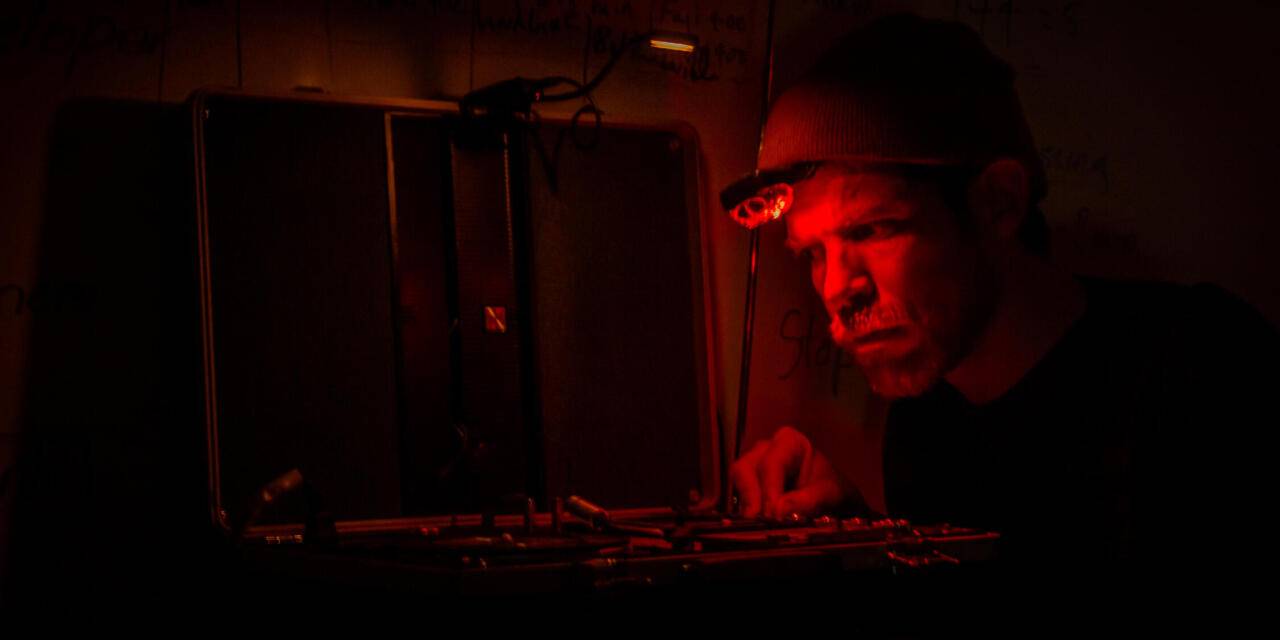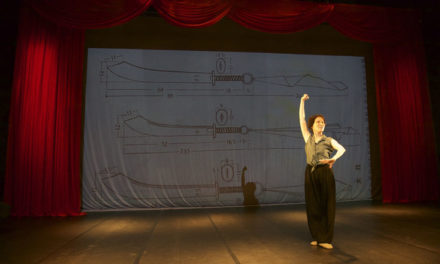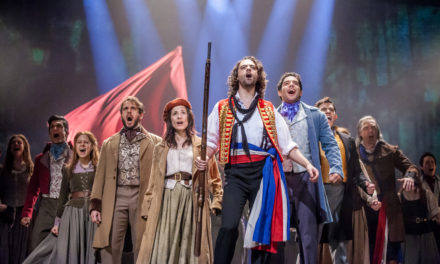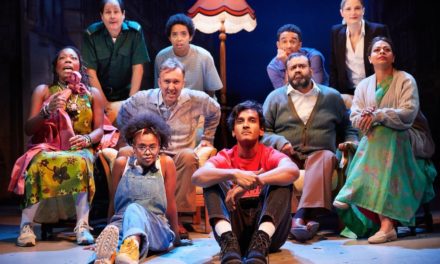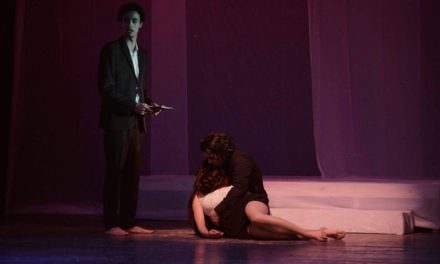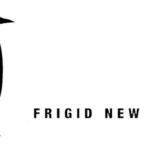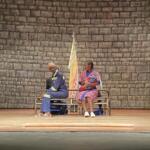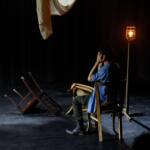A new show from Trick of the Light theatre company is always something special, and Suitcase Show—presented as part of this year’s New Zealand Fringe Festival—is no exception.
The core of Trick of the Light is the creative partnership between its co-founders: director/designer Hannah Smith and actor/writer Ralph McCubbin-Howell. Since the company was established in 2011 their work has toured extensively throughout New Zealand and Australia, as well as to the U.K., U.S.A., Canada, South Africa and China. Their last show The Griegol was a masterpiece of imaginative storytelling and technical wizardry that won best director, composer and production of the year at the 2022 Wellington Theatre Awards.
As the company thrives on touring their work around Aotearoa and overseas, they are acutely aware of the need for more sustainable touring practices. Trick of the Light is driving a Green Theatre project that seeks to create more environmentally friendly methods of theatre production, currently working with PANNZ (The Performing Arts Network of New Zealand) and Playmarket (the national playwrights’ agency) to write a guidebook on environmentally sustainable touring theatre. In developing Suitcase Show, the company has recycled, composted and minimized buying new items. A sign at the Gryphon Theatre bar tells us that anyone who rode their bicycle to the theatre gets a $1 discount off their drink, or if you brought your own cup, you get 50 cents off.

Ralph McCubbin-Howell in Suitcase Show, Trick of the Light Theatre 2024. Photo credit: Romina Meneses
We enter the darkened, smoky auditorium where we’re greeted by Ralph who explains that this is a new work in development therefore there may be some technical glitches which he explains are part of the making process. It’s a full house and Ralph’s warning adds an extra level of risk and adventure to the show.
The show opens with a stunning lighting effect as an open doorway upstage right illuminates a stacked collection of vintage suitcases. Beside these a tiny figure rotates on the turntable of an antique record player. Hannah sits at a console downstage left, her back to us so we can see an array of screens from which she will operate the show. Ralph appears in silhouette in the doorway, dressed in trenchcoat and fedora hat, casting a menacing shadow over the suitcases, instantly transporting us to a film noir-like world. Hannah speaks into her microphone, with her voice coming out in a dreamlike, oddly disembodied treatment: “Do you have anything to declare?”
Ralph’s mysterious traveller has arrived in border control, and all of the technical effects transport us to that limbo-like void between arrival at a strange airport and entering a new country. Two bare lightbulbs hanging above Ralph suggest an interrogation room, while Hannah’s eerie, disconnected vocals evoke the inhuman nature of border transactions with their bewildering, authoritarian rituals. Everything is weirdly disorientating, including the traveller’s responses: “I didn’t pack these bags myself”.
These suitcases are full of stories. As the traveller opens each case, a light glimmers from within and a new story is revealed. Each story evokes a different world through lighting, miniature figures, shadow puppetry and projection and is beautifully told through Ralph’s often poetic, sometimes humorous narration, accompanied by a variety of puppetry techniques. A torchlight becomes a bird in flight. Ralph’s hands become a pair of dancing lovers with illuminated eyes. A model train speeds through a snowy landscape. An endearingly retro spacecraft shuttles through different time periods. The stories are lit by an array of small portable lamps, which Ralph re-arranges in a complex choreography. Ralph is a playful, inventive storyteller, simultaneously narrator, puppeteer and technician. The constantly-evolving design is an inspired collaboration between Trick of the Light and the Auckland-based production design company Filament Eleven 11. Tane Upjohn-Beatson’s cinematic soundtrack goes through a host of different musical styles and beautifully conjures the atmosphere of each world.
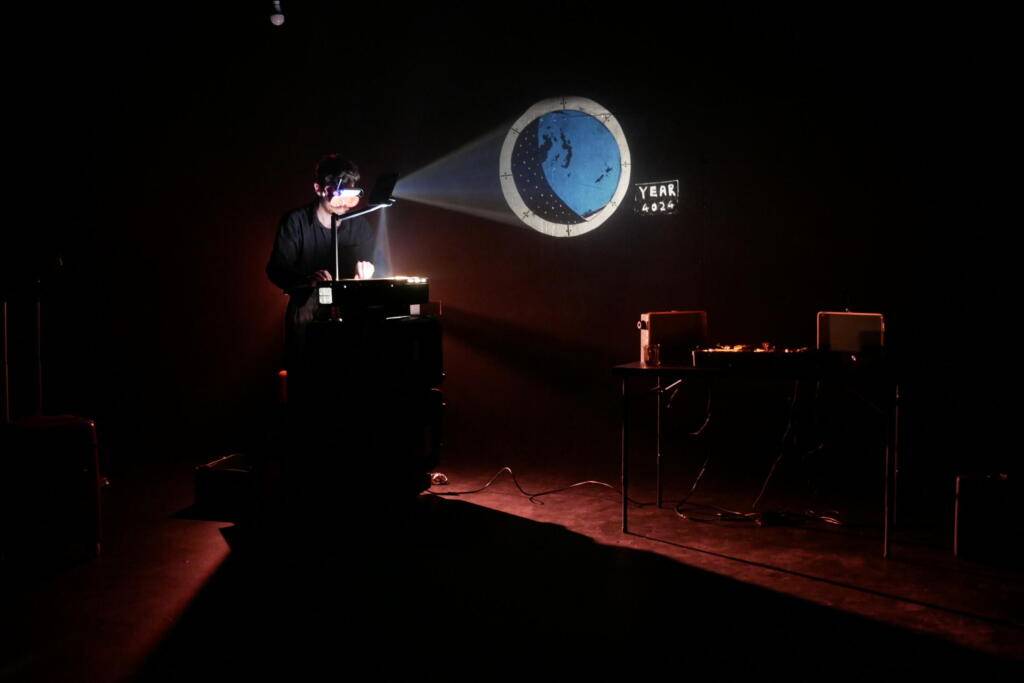
Ralph McCubbin-Howell in Suitcase Show, Trick of the Light Theatre 2024. Photo credit: Rebekah de Roo
The episodic format and themes of travelling/pilgrimage recall Geoffrey Chaucer’s The Canterbury Tales, a connection which is made overt near the end of the show. The border control encounter is an ironic equivalent of Chaucer’s framing device of a group of pilgrims making their way to the shrine of Thomas Becket. In contrast to the amiable Host in Chaucer’s tales, Hannah Smith creates a wonderful satiric portrait of an impersonal border official. Whether quizzing the new arrival, scanning his luggage or chomping on a sandwich, she is inhospitable, distant, bored, embodying the sterility of the modern airport experience. As in Chaucer’s literary classic, the satisfaction of a tale well told stays in constant balance with the anticipation of a new story and characters leading us off on an unexpected journey to a contrasting world. Between stories, we return to the official and the traveller, as the tensions and ambiguities of their encounter builds.
The stories, set in locations across the globe and even in outer space, are radically different in style and tone, yet as I reflected on the show, the more connections I could see between them. The first of the stories, “Box of Birds” is an environmental parable set in a mining town. “The Autocrat” tells the story of the rise and fall of a political leader of an unnamed state (played by Ralph with an Eastern European accent and a fur hat) and with obvious parallels to some of the terrifying dictators who dominate current global politics. “Footprints on the Snow” re-visits a sequence from a previous Trick of the Light show The Devil’s Half Acre (2016), a chillingly uncanny tale about the death of a young girl in 19th century Dunedin. The final story is Chaucer’s “The Pardoner’s Tale”, a warning against greed, in which three young men set out to kill death but end up killing each other. Common themes emerge from these modern morality tales – mortality, environmental crisis, existential fear, surveillance culture, relationships between humans and animals, the lust for power, the destructiveness of the human race, human avarice balanced with the desire for connection and survival. In the programme, Trick of the Light describe Suitcase Show as “odysseys of travel in a world that’s falling apart”, yet their ingenious creativity left me with a sense of gritty resistance and hope, not despair. The episodic structure of the individual tales balances with the overall narrative of the border interrogation, with a satisfying, outrageously dark climax that ties all of the elements together.

Ralph McCubbin-Howell in Suitcase Show, Trick of the Light Theatre 2024. Photo credit: Romina Meneses
One reason that I get great pleasure from Trick of the Light’s shows is that they share their theatrical curiosity with their audiences. We share in their enjoyment of playing with gadgets like miniature lights, head-lamps, overhead projectors, record players, computers and a mix of live and recorded sound effects, in conjunction with sparkling, intelligent storytelling honed by rigorous development seasons. At the same time, I don’t underestimate the technical skill and precision required to perform work of this complexity. Always experimenting, Trick of the Light live up to their name by putting the “trick” back into theatricality, re-inventing that old cliché, the “magic” of the theatre. Even if still in development, Suitcase Show is a richly satisfying experience, a virtuoso display of Trick of the Light’s expertise in small-scale, big vision theatricality.
For further insights into Trick of the Light’s process, I asked Ralph McCubbin-Howell and Hannah Smith a few questions:
DOD: In terms of the sustainable touring concept, does most of the set, lights and equipment fit in the suitcases we see onstage?
RMH/HS: It will. For that first season at Gryphon we had some spares and tools on hand as we were still varying the combination of stories and tweaking the design, but once we take it on the road the idea is that everything is practical – the smaller suitcases will fit into the larger ones onstage, so that it packs down to maybe four large cases and everything used in transit is also used in the show. Part of our concept in making this was to design something for a Fringe season where you are sharing the stage and storage is limited backstage, so having things on wheels and able to pack down is an asset.
DOD: Was that an overhead projector alongside the digital projection? Why do you still use old-fashioned technology when you have access to very high-tech digital projection devices?
RMH/HS: In the Space story we’re using an old school OHP projector (which conveniently packs down to briefcase size). We found something delightful about the retro-futurist feel of legacy technology for a story set in the distant future. Also we love the shadows and textures the OHP can give us (digital projection can do many other things, but can’t quite compete). The lo-fi technology means audiences can immediately understand how it works, and know it is happening live with no pre-recording.
DOD: How did the collaboration with Filament Eleven 11 work?
RMH/HS: We love to create with Brad and Rachel (Filament Eleven 11) – they are such artists, and have a great eye on the whole show. They are certainly interested in new technology which is exciting (how about those two little “hand” puppets with controllable lighting built into old head torches?) but also expensive, and means we need more equipment to be able to run the whole show. Practically, our collaboration means that we work on stories and staging in a rough and ready way, focussing on the narrative, text, audio, timing, and usually creating a gestural version of the aesthetic (i.e. using two normal head torches as hand puppets). Then Brad and Rach come down from Tāmaki for a few days and feverishly build bespoke / better versions. There is a lot of back and forth – they care a lot about the dramaturgy and the story-telling, and we care a lot about the design.
DOD: I can see that the stories are thematically linked although they’re in very different styles. What was the process in choosing which stories to tell?
RMH/HS: We made about 35 minutes of the show over the last two years through a series of work-in-progress showings which gave us a bunch of content to start with and then we thought about what flavours were missing from the buffet. We went into our “final” development knowing we wanted a cute story where people went “Aww” and a serious story that made people feel some stakes. The sequencing was interesting – unlike previous shows where we’ve started from the overarching narrative and then detailed further and further, here the process was more like a musician assembling an album perhaps, or a stand-up comedian building a show from sections of shorter material. We had the broad narrative shape in mind, but this was quite an open framework for the individual stories. We wanted to make sure the rhythms and emotional journey was right, but we also had some things that had to happen in a certain order because of when we unpacked and set up the lighting etc. To be honest we will probably keep fiddling with the sequencing, and swapping in and out some stories for years to come.
DOD: I love the concept of having Hannah onstage as the operator and director and showing all of the technical operation to the audience. As I recall you did the same thing in Tröll.[1] Is it an important part of your strategy to let the audience see how the magic works, and if so why?
RMH/HS: We first tried something like this with Tröll but it grew out of our experience putting on The Road That Wasn’t There[2] — theatre where audiences were always curious to look backstage to see how we were creating the shadow puppetry images. It’s something we explored further with The Griegol where we placed the lightbox downstage in view of the audience. Theatre can’t compete with film in terms of creating spectacle, but what it can do is something transformational within the room – you show the audience your hand, they see all the elements, and then you do something magical with them.[3]
Suitcase Show
Trick of the Light Theatre,
Gryphon Theatre, Wellington 29 February – 2 March 2024
New Zealand Fringe Festival 2024
Director: Hannah Smith
Writer: Ralph McCubbin-Howell
Performed by Hannah Smith and Ralph McCubbin-Howell
Sound design and composition: Tane Upjohn-Beatson
Production and technical design collaborators: Brad Gledhill and Rachel Marlow (Filament Eleven 11)
[1] Tröll (2017) is a dark digital fairytale in which a lonely boy seeks solace in internet chatrooms.
[2] The Road that Wasn’t There (2012) is a fable about a young woman who strays onto a paper road and finds herself in an imaginary world.
[3] Email from Trick of the Light 14 April 2024.
This post was written by the author in their personal capacity.The opinions expressed in this article are the author’s own and do not reflect the view of The Theatre Times, their staff or collaborators.
This post was written by David O'Donnell.
The views expressed here belong to the author and do not necessarily reflect our views and opinions.

